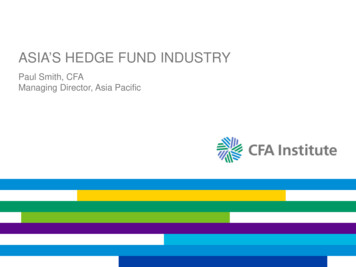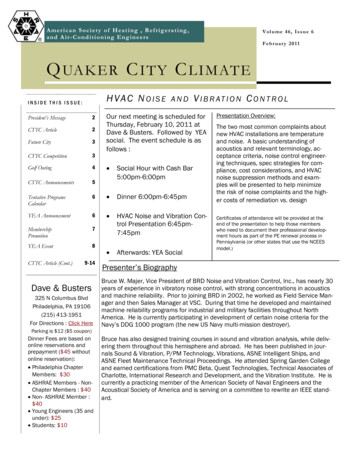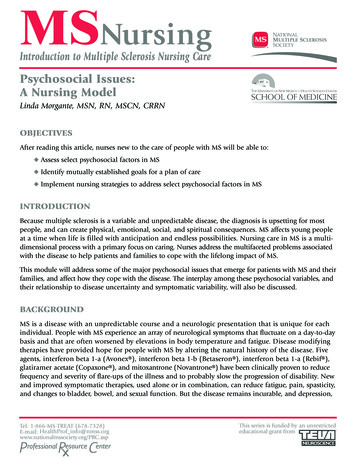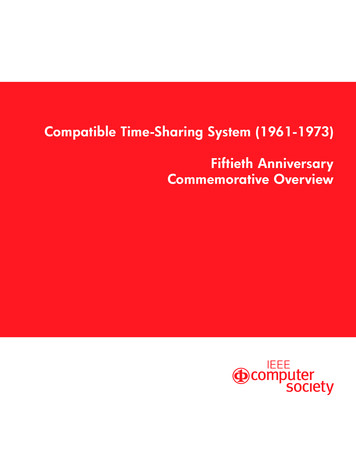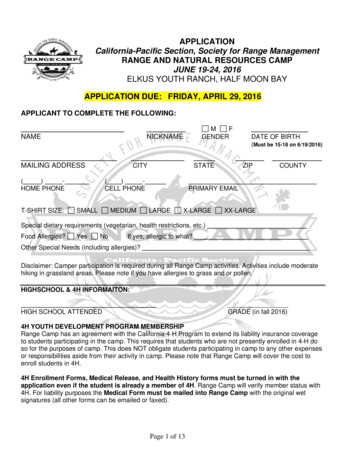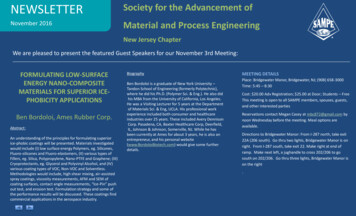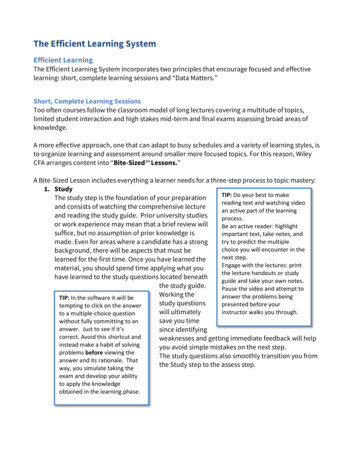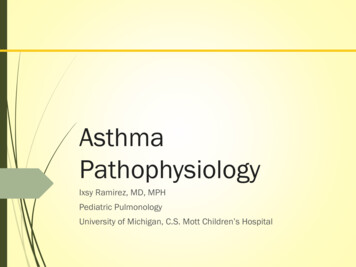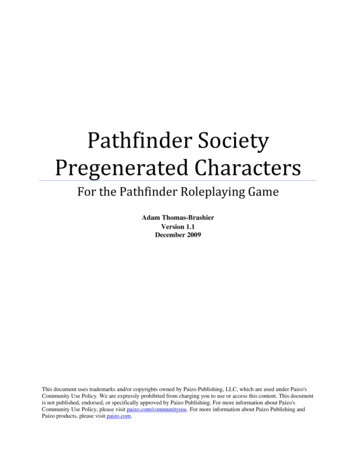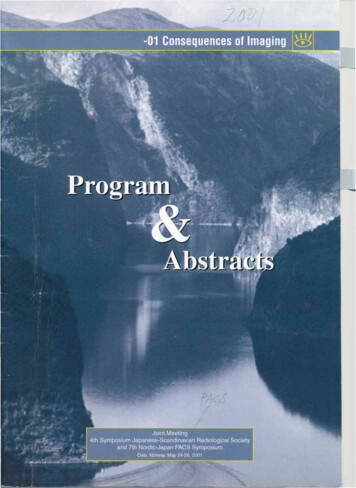
Transcription
The Alkan SocietyRegistered Charity no. 276199www.alkansociety.orgPresident: Leslie HowardVice-presidents: Anne Smith, Hugh Macdonald, Nicholas King, RichardShawHonorary Officers: Mark Viner Chairman, Nick Hammond Treasurer, CoadyGreen SecretaryBulletin 95: December 2017Society concertsSociety concert series: Jan HugoSt Mary’s Church, Ealing, London on 3rd March 2017With the support of the Keyboard Charitable Trust, theSociety sponsored a recital by the South African Jan Hugo,prize winner of the 2014 Royal Overseas League piano competitionand the 2016 Alkan-Zimmerman competition. Jan’s programmeincluded four of Alkan’s preludes from op. 31 and the QuasiFaust movement from the Grande Sonate (op. 33), as well as twoof Debussy’s preludes (Danseuses de Delphes and La puerta delvino) and Liszt’s Légende I (St Francis of Assisi Preaching to theBirds), Sarabande and Chaconne from Handel’s Almira and thethird Mephisto Waltz.Later in the year, Jan reached the semi-final stage in the 11thInternational Franz Liszt Piano Competition. The Societycongratulates Jan on his success.Society concert series: Peter de JagerSt Mary’s Church, Ealing, London on 7th April 2017Our next recital was by the Australian pianist and composerPeter de Jager. Peter is one of Australia’s most excitingmusicians, with a repertoire encompassing all periods ofwestern classical music as well as musical theatre and cabaret.Peter won the inaugural Australian International ChopinCompetition in 2011, and was awarded fifth prize and bestAustralian competitor at the Southern Highlands InternationalPiano Competition in 2013. In 2015 he was a finalist in theSymphony Australia Young Performers Award, and in 2016 he wasawarded second prize in the Australian National Piano Award.Peter played Alkan’s Symphonie (op.39, nos 4-7), followed bythe first UK performance of Part I of Chris Dench’s PianoSonata, a work he commissioned following his award of the2014 Freedman Fellowship. The Alkan Society
Alkan Society Bulletin no 95: December 2017Society concert series: Mark Viner and SoYeong KimSt Mary’s Church, Ealing, London on 19th May 2017Our third recital in the series, coinciding the Society’s 2107 AGM, was a piano duet and duoextravaganza by our Chairman Mark Viner and SoYeong Kim.The programme started and ended with works by the colourful Louis Moreau Gottschalk, his Grandmorceau de concert based on Rossini’s William Tell overture (four hands, one piano) and the GrandeTarantelle (op.67) in an arrangement for piano duo. The filling of the sandwich consisted of Alkan’s TroisMarches (op.40) and the Variations-Fantaisie sur deux motifs de Don Juan (op.26) (both four-hands) andLiszt’s own adaptation of his Symphonic Poem Mazeppa for piano duo (S.640).Forthcoming eventsJoint societies dinner-recitalLancaster Hall Hotel, London on 17th January 2018 (17:30 for 18:15)The annual dinner-recital, held in conjunction with relatedmusic societies, is presented in 2018 by the Schubert Society, incollaboration with the Alkan, Liszt, Mahler and Wagner Societies.Works by all of these composers will be included. The Alkancontribution will be performed by Andrew Yiangou, who wasawarded the prestigious Mills Williams Junior Fellowship at theRoyal College of Music for his studies on the Artist DiplomaCourse 2016/17. Andrew will be playing the third and fourthmovements of the Symphonie for Solo Piano (op. 39, 6-7).Attendance is restricted to members of the participating societiesand their guests. Tickets ( 43, including dinner and wine) may ersociety.org) or from their ticket rship newsAs of November 2017, there are 95 fully paid-up members of the Society (including Honorary members);there are seven student members.Whilst the largest number of members are from the UK (68), 11 other countries are represented,including USA (14 members), Australia (7), Germany (5), France, Japan and the Netherlands (4 apiece),and Austria (3). Eight new members have joined us in 2017 so far. This is all good news: our membershipis rising year-on-year, albeit modestly!Page 2 The Alkan Society
Alkan Society Bulletin no 95: December 2017Premio Alkan per il virtuosismo pianisticoHartmut Schock, Gebhardshain, GermanyOn the 17th of June 2017, the first Alkan Award for piano virtuosity took place at the Castello di Castano,Agazzano in Italy. The Patron of the event was Vincenzo Maltempo, and the members of the ArtisticCommittee were Professor Mauro Porta, Enrico Lainati and Eric Véron. Member Hartmut Schockrepresented the Society at the event, and reports as follows.Never before had I witnessed such a pianospectacle, a musical fairy tale of thehighest enjoyment for all the senses. Theevent took place in a wonderful summerlandscape in villages and towns – andalways among friendly people. I was reallyglad I had applied to attend. An illustriouscircle of about 125 Alkan fans from allover the world met in the park of theCastello.Guests were picked up from the parkinglot with little electric carts, greeted andinvited for an initial drinkAt 7pm, the evening started in thecourtyard of the Castello.VincenzoMaltempostartedtheprogramme with Comme le vent,Prestissimamente. The only piece from op.39 which might reasonably be describedas a Study is the one which opens it, at“a hair-rising speed of 160 2-16 bars tothe minute, or 16 notes to the second.”(Ronald Smith, 1978, booklet EMIRecords Ltd).Maestro Maltempo realised this inunbelievable speed, every note sparkled, no blurry notes – breathtaking! In the middle of the etude, heapplied the 2, 3, 4, 5 fortissimo chords in a veryeffective way and then rushed on. Finally, the “windmusic” lost its power, only a small breeze was left.I have listened to the “symphony” four times: 1988in London performed by Ronald Smith, twiceperformed by Marc-André Hamelin and now byVincenzo Maltempo. I really enjoy this piece ofmusic a lot. The dark beginning captures me everytime I hear it – brilliantly played by Maltempo. Heplayed the second movement slightly slower thanHamelin. In my opinion, that is the appropriatetempo for a funeral march. Maltempo emphasisedeffects of impact and accentuation, I’ve never heardit like this before. Also the F-major-middle section –a glimpse in heaven! The dry chords at the end of thefirst movement, from the piano e staccato to the tripleforte, seemed to chase each other - very impressive!After flashing past the Minuet and Trio, the finale, Presto, arrives. Raymond Lewenthal has described therelentless finale as “a ride in hell”. How can one play the staccato-octaves of the left hand so fast?Confidently and with virtuosity, Maltempo chased through hell. The Alkan SocietyPage 3
Alkan Society Bulletin no 95: December 2017He continued with a strange piece: Number 8 of the 25 Preludes op. 31, La chanson de la folle au bord de lamer (in A-flat minor). One can understand that, both in the dark bass and in the desperate circling of thevery simple melody of the right hand, the mad woman is trapped in her illness.This was followed by a firework of piano music, the second rhapsody of Liszt, which Maltempo burnedthrough in confident virtuosity and certainty, to the fascination of the guests. Receiving his applauseand introducing the intermission, he seemed as fresh as at the start.The host invited us to an excellent dinner in a terrific ambiencewith the best of weather. During intermission, I got the chance tointroduce myself to Maestro Maltempo (pictured right with theauthor), to thank him for the friendly and generous invitation andto pass on the greetings of the Alkan Society.While the guests had an excellent snack, the host took the chanceto tune up the piano. After intermission, the first winner of theAlkan award presented himself to the audience; a very friendlyyoung man, Raffaelo Battiloro.He started his programme with Liszt’s Rigoletto Paraphrase. It was immediately apparent how great hisart already is: a sparkling, clean thunderous keys, elegant arrangement of the paraphrase. Never had Iheard a Steinway produce such delicate sounds so softly. Maybe the special atmosphere in the atriumadded to it. This was followed by Le Festin d’Esope, the last of the 12 op. 39 etudes, which was surelyeagerly awaited by all Alkan fans. Now Battiloro could really show off the magic of his piano playing –really, a worthy first-prize winner. Bravo!11The performances are available at:www.facebook.com/premioalkan/?hc ref ARSNME0P 6wtlIXI&fref nfPage 4 The Alkan Society
Alkan Society Bulletin no 95: December 2017As a special at the end, Maltempo and Battiloro played the Grande Tarantelle by Louis MoreauGottschalk2, a happy, fast dance, which was played by both pianists with a lot of fun and verve.Finally, the award ceremony. Professor Porta presented the award, complimented everyone andthanked the sponsor of the event, Vailog (A Segro Group Company), from Assago Milanofiori. Professor Portais on the left in the picture, togetherwith Raffaelo Battiloro, VincenzoMaltempo, young pianist Emma Bertola(the grand-daughter of the Castello’sowner) and Eric Véron of Vailog.A wonderful extraordinary pianohappening, unforgettable hours ofspecial music were presented to theaudience by two very special pianoplayers3.English translation by Elisabeth Schock, Hannover2It’s absolutely worthwhile to learn more about the life and work of L. M. Gottschalk (8 May 1829 to -18 Dec 1869). No pianist ofthe 19th century is likely to have travelled further for concerts than he has. Only in two years, he has travelled 80,000 milesthrough North America (“Don’t shoot the piano player!”). He wrote US ethnic and patriotic music (e.g. Bamboula, Le Bananier,La Savane, The Banjo, Union, ), Music from Spain (Manchega, ), West Indian souvenirs (e.g. Souvenir de Porto Rico, Marchedes Gibaros!!) and Concert and Salon Music (Pasquinade, The Dying Poet, ). See: Starr, S. F. (1959), Bamboula! The Life and Timesof Louis Moreau Gottschalk, New York & Oxford.3Luckily, I had a little time left, to visit the “Museo del Violino” in Cremona the following day. There, one can admire violes,celli, string basses which belonged to Stradivari, Amati, Guarneri and many other masters. Also modern instruments aredisplayed; the best instruments which are annually identified in a competition can be seen there. The Alkan SocietyPage 5
Alkan Society Bulletin no 95: December 2017Connecting Berlioz and Alkan: a Germanic language in 19th-century ParisLaura Snyderman, Peabody Institute, BaltimoreWhile differing in many respects, Berlioz and Alkan shared a common interest in building on the worksof the preceding Austro-German musical traditions of Beethoven and others. This paper serves tocompare and contrast select Alkan and Berlioz compositions, and assess their shared and differingmusical tastes as a result of Germanic influence.As a result of the political and social upheaval from the French revolution, the turn of the nineteenthcentury brought new waves of influence into the Parisian musical scene. With the founding of the ParisConservatoire in 1795 in an attempt to compete with Italian and German institutions, the Conservatoireopened its doors with the goal of providing a more standardized educational system for musicians, witha distinctly French system of musical study (Mongrédien & Pauly, 1996, p. 14, 21). By the nineteenthcentury, the Paris Conservatoire had a thorough systemization in its teaching practices, implementingits own publications and standardizing curriculum based on French manuals. As romantic sentimentgrew in artistic and literary fields as a result of the new social individualistic ideals commanded withthe political upheaval, the Conservatoire further laid the foundation for Paris to become one of themain cities for musical performance and study.Ironically, German music, in particular Beethoven’s works, had a profound effect on Parisian musicalcircles. Notwithstanding some of the initial criticism from the “violent polemics that were tinted withobvious nationalism,” Germanic music was eventually adopted into its curriculum with the help ofGerman pianists’ successful reception in the Parisian concert scene, and, more importantly, Habeneckand Cherubini’s insistence on its performance (Mongrédien and Pauly, 1996, p. 316, 323). Whatoriginally stemmed from a nationalistic wave paved the way for the Paris Conservatoire’s mostsuccessful and potentially peculiar students, Berlioz and Alkan among them, in revolutionizingconventional musical forms towards a new harmonic language. Sharing a mutual affinity for Germanicinfluences in their compositional output, and in particular Beethoven’s contributions, Berlioz and Alkanutilized the Germanic inspiration in their works as they strove to find their own unique voices in anenlightening and conflicting time for Parisian musical language.Berlioz entered the Conservatoire in 1826, around the time Alkan was beginning to gain influence in theParisian salons outside of the Conservatoire. After hearing a performance of Beethoven’s third and fifthsymphonies conducted by Habeneck at the Conservatoire in 1828, Berlioz remarked that, “Beethovenhad opened before me a new world of music, as Shakespeare had revealed a new universe of poetry”(Macdonald, 2005). This was pivotal, as Berlioz had only written vocal music prior to this point in hiscareer, leading to the premier of the famed Symphonie Fantastique a short two years following(Macdonald, 2005).Symphonie Fantastique was revolutionary, leading to extreme opposition in musical criticism for itsexpansive instrumentation, unlike any other symphony prior, and for its programmatic quality. Itsmusical language, while new and inventive, presents clear influences from the Germanic music ofBeethoven and Weber in its key choices, in its musical devices, and even, to some degree, in its use ofform.Fétis de
The dry chords at the end of the first movement, from the piano e staccato to the triple forte, seemed to chase each other . This was followed by a firework of piano music, the second rhapsody of Liszt, which Maltempo burned through in confident virtuosity and certainty, to the fascination of the guests. Receiving his applause and introducing the intermission, he seemed as fresh as at the .
